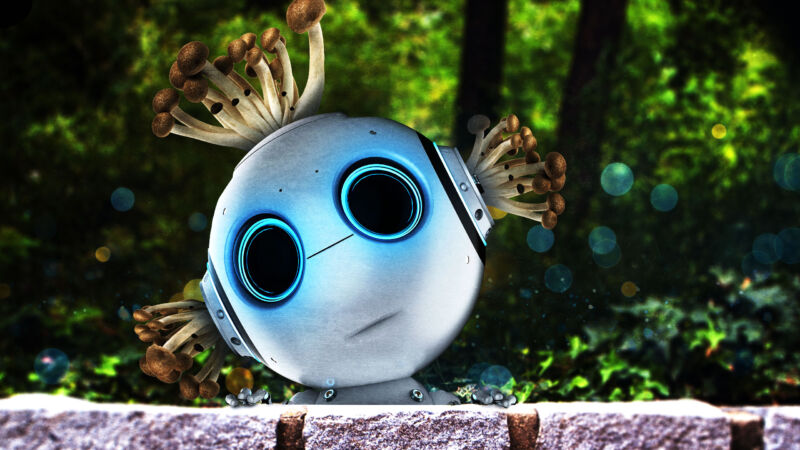
Aurich Lawson | Getty Images
Most living organisms easily surpass machines when it comes to navigating real-world environments and adaptability to changing conditions. One way to bridge that gap is building biohybrid robots that merge synthetic machinery with biological components like animal muscles, bacteria, or plants.
But living muscles are very hard to keep alive in a machine, bacteria have a very short lifespan, and plants tend to react to things a bit slowly, like Ents in The Lord of the Rings. So, a team of scientists at Cornell University went down a different path and built biohybrid robots controlled by fungi, specifically, oyster mushrooms.
Understanding mushrooms’ signals
Robots controlled by fungi, despite giving strong Last of Us vibes, are a good idea on paper. Fungi are very easy to sustain and can live pretty much everywhere, including extreme environments like the Arctic, or even amid nuclear contamination. They’re also cheap to culture in large quantities and excel at reacting to environmental cues like exposure to light.
The key challenge, though, was interfacing them with robots, because how can you connect a robot to a mushroom?
“Previously the connection between a fungus and an electrical machine was done by imaging [how rapidly it was growing]. The new thing that we did was a direct connection to the mycelium and then using it to control a machine,” says Robert F. Shepherd, an associate professor of mechanical engineering at Cornell and co-author of the study. The mycelium is a large network of branching filamentous structures called hyphae, which are often located underground. Fungi use it to sense the environment and communicate with each other through electrical signals.
The trick to interfacing the mycelium with an electrical system was to culture it in a 3D-printed scaffold until it basically grew into the electrodes after 14 to 33 days. But making a stable connection was one thing; reading its signals was quite another.
The team recorded the electrical activity of mushrooms over 30 days and then analyzed what they saw. To start, all signals below 5 microvolts were classified as noise. Then, the team sampled the data at 30-second intervals and applied a digital filter to smooth out anything below these 5 microvolts and remove electronic noise. This way they could precisely identify, measure, and characterize peaks in the fungal electrical communication. Once this was done, Shepherd and his colleagues started to test how the fungi react to simple stimuli like exposure to UV light at various intensities. When that was done, the scaffolds with the fungal mycelia and electrodes were shielded from vibrations and magnetic interference and installed in two robots: a walking one resembling a starfish, and a more standard four-wheeled rover.
The team demonstrated the mushrooms could control the robots by having them move toward or away from a UV light source.
Still, this means that the mushroom-powered control units, with all their shielding and signal processing, accomplished just about what the dumbest off-the-shelf light sensor could do. But fungi, apart from light, can react to chemicals. And in sensing chemicals, they beat pretty much every synthetic sensor on the planet.
Fungal chemical detectors
“The clear thing to do now, once we have this more controlled system, is to look at chemical exposures, biological exposures. Living organisms can amplify these signals much better than synthetic systems detecting very, very minute amounts of chemicals,” Shepherd says. He said that using fungi as chemical detectors would be way more challenging, because it would entail matching electrical activity recorded in fungi to their exposure to a wide catalog of chemical stimuli like acidity of the environment or the presence of specific chemical compounds like cyanide.
The most likely way to get that done will be recording large datasets of fungal electrical signals emitted in response to each exposure, annotating them, and then training AI models to interpret the fungal language. Ideally, it would be possible to determine “this electrical pattern means the soil is slightly too acidic.”
“The fungus interacts with the environment and we just need to learn what all the signals mean. How the signal looks like when it encounters something it likes and how it looks like when it hates something,” Shepherd says. A lot of things that kill mushrooms also kill plants, he adds, which makes fungal biohybrid robots potentially useful in agriculture.
“We see such systems as connection points, measuring the health of plants to avoid overfertilizing fields. Imagine a quadruped robot with its feet laden with mycelium sensing locally as it traverses the environment. Or a mycelium grown throughout an entire field and a robot just poking electrodes into this mycelium-rich environment to connect to it,” Shepherd says. The only problem is that fungi, like all living things, eventually die. But the team sees ways around that, too.
“We have the ability to reinject spores and nutrients to regrow over the old mycelium, and that’s going to be a neat kind of thing. The life and death and rebirth of our robots,” Shepherd says.
Science Robotics, 2024. DOI: 10.1126/scirobotics.adk8019




















+ There are no comments
Add yours